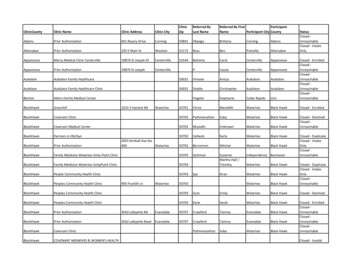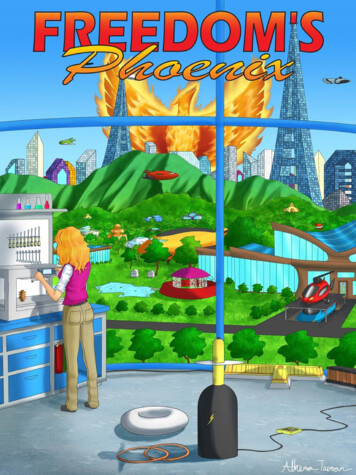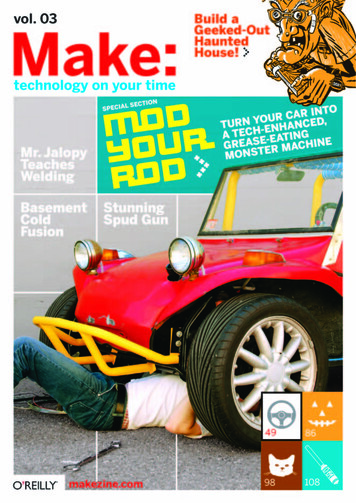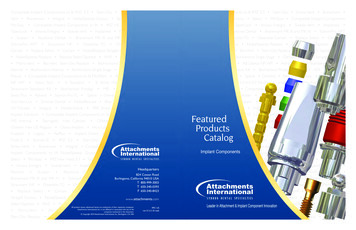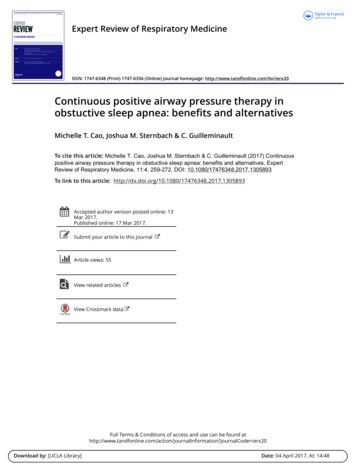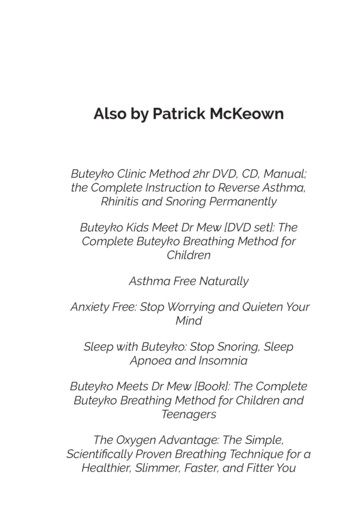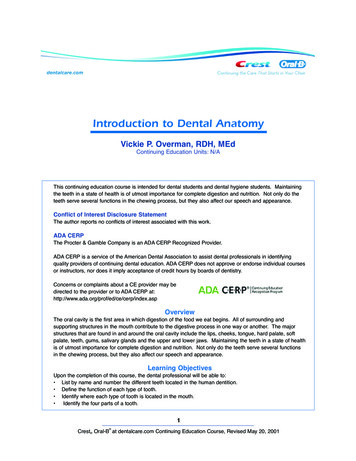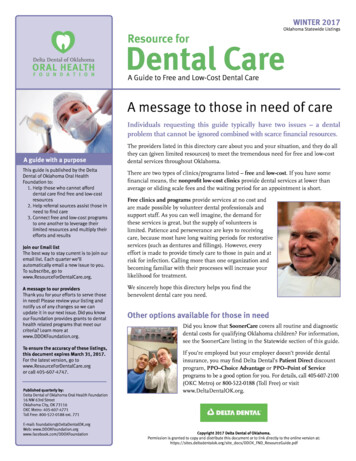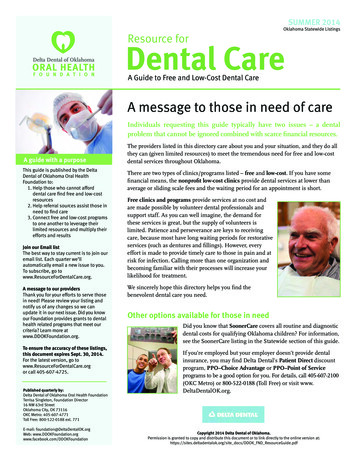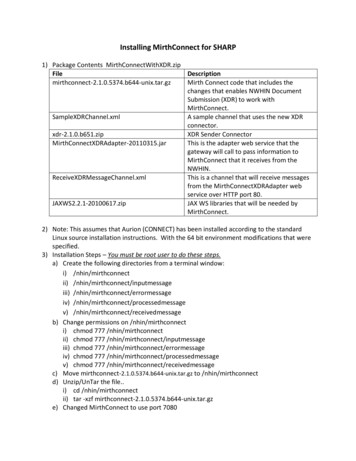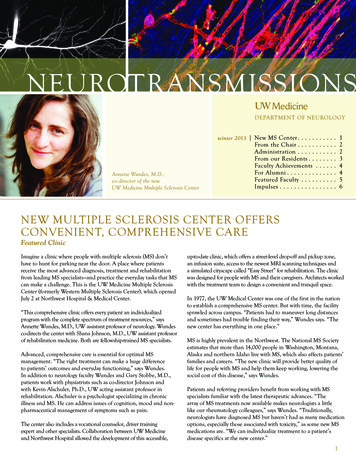
Transcription
NEUROTRANSMISSIONSDEPARTMENT OF NEUROLOGYwinter 2013Annette Wundes, M.D.,co-director of the newUW Medicine Multiple Sclerosis CenterNew MS Center. . . . . .From the Chair. . . . . .Administration . . . . . .From our Residents. . .Faculty Achievements .For Alumni. . . . . . . . .Featured Faculty . . . . .Impulses. . . . . . . . . . .12234456NEW MULTIPLE SCLEROSIS CENTER OFFERSCONVENIENT, COMPREHENSIVE CAREFeatured ClinicImagine a clinic where people with multiple sclerosis (MS) don’thave to hunt for parking near the door. A place where patientsreceive the most advanced diagnosis, treatment and rehabilitationfrom leading MS specialists—and practice the everyday tasks that MScan make a challenge. This is the UW Medicine Multiple SclerosisCenter (formerly Western Multiple Sclerosis Center), which openedJuly 2 at Northwest Hospital & Medical Center.“This comprehensive clinic offers every patient an individualizedprogram with the complete spectrum of treatment resources,” saysAnnette Wundes, M.D., UW assistant professor of neurology. Wundesco-directs the center with Shana Johnson, M.D., UW assistant professorof rehabilitation medicine. Both are fellowship-trained MS specialists.Advanced, comprehensive care is essential for optimal MSmanagement. “The right treatment can make a huge differenceto patients’ outcomes and everyday functioning,” says Wundes.In addition to neurology faculty Wundes and Gary Stobbe, M.D.,patients work with physiatrists such as co-director Johnson andwith Kevin Alschuler, Ph.D., UW acting assistant professor inrehabilitation. Alschuler is a psychologist specializing in chronicillness and MS. He can address issues of cognition, mood and nonpharmaceutical management of symptoms such as pain.The center also includes a vocational counselor, driver trainingexpert and other specialists. Collaboration between UW Medicineand Northwest Hospital allowed the development of this accessible,up-to-date clinic, which offers a street-level drop-off and pickup zone,an infusion suite, access to the newest MRI scanning techniques anda simulated cityscape called “Easy Street” for rehabilitation. The clinicwas designed for people with MS and their caregivers. Architects workedwith the treatment team to design a convenient and tranquil space.In 1977, the UW Medical Center was one of the first in the nationto establish a comprehensive MS center. But with time, the facilitysprawled across campus. “Patients had to maneuver long distancesand sometimes had trouble finding their way,” Wundes says. “Thenew center has everything in one place.”MS is highly prevalent in the Northwest. The National MS Societyestimates that more than 14,000 people in Washington, Montana,Alaska and northern Idaho live with MS, which also affects patients’families and careers. “The new clinic will provide better quality oflife for people with MS and help them keep working, lowering thesocial cost of this disease,” says Wundes.Patients and referring providers benefit from working with MSspecialists familiar with the latest therapeutic advances. “Thearray of MS treatments now available makes neurologists a littlelike our rheumatology colleagues,” says Wundes. “Traditionally,neurologists have diagnosed MS but haven’t had as many medicationoptions, especially those associated with toxicity,” as some new MSmedications are. “We can individualize treatment to a patient’sdisease specifics at the new center.”1
FROM THE CHAIRWelcome to the inaugural issue of Neurotransmissions, the UW Department of Neurology newsletter. Sincebecoming an independent department in 1996, we have grown in size and in the diversity of our activities.The field of neurology itself has become more complex and exciting. Staying connected with one anotherhas never been more important—or more challenging. Thus, we are pleased to have this new way to shareinformation with colleagues, alumni and friends.Engagement with our readers is the goal. Neurotransmissions must serve your needs. Consequently, its formand content range are not hardwired. As we develop our first issues, your ideas for topics or recurring featureswill be especially valuable, so please don’t be shy about offering advice.This issue features UW Medicine’s new multiple sclerosis center. Jointly run by the departments of neurology and rehabilitation medicine, theMS center offers truly comprehensive care in a beautiful new space on the campus of Northwest Hospital and Medical Center. The creation ofthis new center intensifies our commitment to provide MS patients in the Pacific Northwest with the best care possible.Each issue of Neurotransmissions will also feature faculty and staff. “Faculty Achievements” will keep you up to date on faculty awards,honors and especially significant publications. In “Featured Faculty,” we will focus on individual faculty members to provide more in-depthsurveys of professional contributions. This issue highlights the extremely important advances in muscular dystrophy that have come fromthe laboratory of Jeff Chamberlain, Ph.D.“From Our Residents” offers a view of our outstanding training program and news of current residents and fellows. We cordially invite ouralumni to share their adventures and successes (“For Alumni”). In addition, we will bring you some special features. Phil Swanson, M.D., Ph.D.,a UW Medicine faculty member since 1967, is interviewed in this issue for “Impulses,” a column that focuses on history this fall.As you review the first issue of Neurotransmissions, you might wonder, “What took you so long?” Primarily, the delay came from a vaguesense that we were already communicating effectively about important departmental events. The truth is, living in the “information age”does not guarantee that we receive the most relevant news. There is simply too much of it from too many sources. To help makefuture issues of Neurotransmissions as relevant as possible, I am counting on you for suggestions. It is our hope that this newsletter willbecome an essential, enjoyable source of information you can use.Sincerely,Bruce R. Ransom, M.D., Ph.D.Warren & Jermaine Magnuson Professor and ChairDepartment of NeurologyDepartment of Neurology AdministrationBruce R. Ransom, M.D., Ph.D.Warren and Jermaine Magnuson Professor andChair, Department of NeurologyService Chief, Neurology, UW Medical CenterWill Longstreth, M.D.Professor of NeurologyService Chief, Neurology, Harborview Medical CenterSidney M. Gospe, Jr., M.D., Ph.D.Herman and Faye Sarkowsky Chair, Child NeurologyProfessor of Neurology and PediatricsDivision Head, Pediatric Neurology, SeattleChildren’s HospitalJohn E. O’Laughlen, M.B.A., DirectorNeurotransmissions Editorial BoardBruce R. Ransom, M.D., Ph.D.John E. O’Laughlen, M.B.A.Genevieve J. Long, Ph.D.Megan Schade2William Spain, M.D.Professor of Neurology and Physiology and BiophysicsService Chief, Neurology, VA Puget Sound Health Care SystemKass Klemz, Assistant to the ChairDepartment of NeurologyUniversity of Washington School of Medicine1959 NE Pacific St. RR650 Box 356465Seattle, WA 98195Phone 206.543.2340 Fax 206.685.8100www.neurology.washington.edu
continued from coverThe new center also offersleading-edge diagnosis, includingelectrodiagnosis, spinal tap and theexpertise to rule out MS mimicssuch as neurosarcoidosis. “We willsee any patient with suspected MS,”says Wundes. “The center workswith many community providers,including neurologists and primarycare physicians.” Providers can callwith questions or refer patients forsecond opinions or collaborative care.“Many people with MS need differenttypes of care at the same time,”Wundes says. “This can overwhelma community clinic.” The center’sresources include support groups,monthly patient education classesand nutrition counseling. The MScenter works closely with the NationalMultiple Sclerosis Society (NMSS)to maximize community support forpatients and to advance communityand peer education. Wundes serveson the NMSS board of trustees andchairs its 2013 regional summit.The center is also committed toresearch. Ongoing projects includea study of stem cell therapy forpatients with aggressive MS whodon’t respond to standard treatment,in partnership with researchers atFred Hutchinson Cancer ResearchCenter. Neurology faculty also workwith Department of Rehabilitationcolleagues studying quality of life inthe UW Medicine MS RehabilitationResearch and Training Center.Ultimately, this is the goal of theMS center and its specialist teams—making life for Northwest residentswith MS as good as possible. Tolearn more about the UW MedicineMultiple Sclerosis Center, visithttp://www.uwmedicine.org/msContact information:Multiple Sclerosis Center1536 North 115th StreetSuite #130Seattle, WA 98133-9733206.598.33443FROM OUR RESIDENTSAbout the Neurology ResidencyEach year, the Department of Neurology recruits a talented class of dedicated,intellectually curious physicians. Residents look forward to training withour committed faculty and seeing a diverse patient population. Beginningin 2012, we have six adult neurology residents per year (18 total). Followinga year of internal medicine training residents rotate among UW MedicalCenter, Harborview Medical Center, the VA Puget Sound Health CareSystem and Seattle Children’s. Starting this year, rotations also include theUW Medicine Multiple Sclerosis Center at Northwest Hospital.Approximately 75 percent of our residents enter fellowship training.Graduating residents accepted the following fellowships in 2012:Marie Davis, M.D., movement disorders, UW Medical CenterJohn Jefferson, M.D., clinical neurophysiology, UCLAElham Rezvanian, M.D., sleep medicine, UW Medical CenterConor Sheehy, M.D., sleep medicine, Oregon Health & Science UniversityThe Department of Neurology offers fellowships in headache, movementdisorders, clinical neurophysiology, sleep medicine and vascular neurology (stroke).About Our Pediatric Neurology ResidencyThis is a five-year categorical program linked to the UW School of Medicinepediatrics program. It includes two years of general pediatrics, integratedtraining and education through the school’s core neurology residencyprogram and extended,intensive training inpediatric neurology atSeattle Children’s. Slots arefilled through the NationalResidency Matching Program.2012 Awards toResidentsNeurology Residents 2011-2012Front row, left to right: Anitha Raghunath, M.D.,Erica Byrd, M.D., Krista Kawaguchi, M.D., AliSultan-Qurraie, M.D., Marie Davis, M.D., Ph.D.,John Jefferson, M.D., Michah Brasseur, M.D., JennaKanter, M.D., Katelan Longfellow, M.D. Back row,left to right: Residency program coordinator RobertYoung, Conor Sheehy, M.D., Chris Beatty, M.D., LizCahill, M.D., Elham Rezvanian, M.D., Ning Zhong,M.D., Max Ma, M.D.John Jefferson, M.D.,class of 2012, received theHarborview Medical CenterHousestaff AchievementAward for Clinical Ability andHumanitarian Concern. Oneresident each year receives thisaward based on nominationsand selection by a committee.Anitha Raghunath, M.D.,class of 2013, received theDr. Alexander SpenceAward, given each year to aneurology resident who showsexceptional dedication inneuro-oncology patient care.
FACULTY ACHIEVEMENTSFOR ALUMNIWelcome to Neurotransmissions,the Department of Neurologynewsletter. We hope it helpsyou keep up with departmentactivities.ALS Study FundedMichael Weiss, M.D., has receivedtwo awards to fund a two-year,Phase 2 multicenter randomizedcontrolled study of the drugmexiletine for amyotrophic lateralsclerosis (ALS). Awards include 355,328 from the Northeast ALSConsortium and 740,630 fromthe ALS Therapy Alliance. Thestudy will enroll 60 patients at 10sites beginning in November 2012.Neurology Grand RoundsEarn CME creditsof Top Doctors. The 2012 listincludes Kyra Becker, M.D., MarcChamberlain, M.D., Sidney M.Gospe, Jr., M.D., Ph.D., EdwardNovotny, M.D., and Ali Samii,M.D. Kudos to our facultymembers for this recognition fromthe Seattle community.UW Medical CenterHonors Faculty for ServiceFaculty Member JoinsNational CommitteeNathaniel Watson, M.D., wasappointed to the executivecommittee of the American Academyof Sleep Medicine (AASM) in June2012. With more than 10,000members, the AASM is the world’slargest sleep physician membershiporganization.Several neurology faculty werehonored at the annual UWMCEmployee Service Awardscelebration. Nigel Bamford, M.D.,and Jonathan Weinstein, M.D.,Ph.D., were recognized for 10years of service, while AndreaCheng-Hakimian, M.D., MarcChamberlain, M.D., and Gene Hu,M.D., Ph.D., marked their five-yearservice milestones.2012 Teaching AwardsMike Kim, M.D., received the AdultNeurology Teacher of the Year Awardand John Kuratani, M.D., receivedthe Pediatric Neurology Teacherof the Year Award for work withDepartment of Neurology residents.Seattle’s Top DoctorsInclude Neurology FacultyNeurology faculty are frequentlynamed to Seattle Magazine’s listAbove, right: Imaging of mitochondria(yellow) in cultured neurons (green)to measure mitochondrial fusion,fission and localization. Experimentand images by Galen Udell Pizzorno.Photo courtesy of the Jayadev andGarden labs.Above, left: Brain circuits withinthe striatum. Photo courtesy of theBamford lab.The new Neurology website iswww.neurology.washington.edu. You can watch livestreaming Grand Roundslectures every Thursday from4:15 p.m. to 6 p.m. Interestedin earning continuing medicaleducation (CME) credits? s/grandrounds/ For moreinformation, contact MeganSchade, neurogr@uw.edu.Alumni at the AAN?Would you like to attend analumni event at the AmericanAcademy of Neurology? The65th annual meeting is March16-23, 2013, in San Diego,Calif. If you’re interested, emailschadm@uw.edu.Neurology History ProjectSandeep Khot, M.D., M.P.H.,Will Longstreth, M.D., andPhillip Swanson, M.D., Ph.D.,are gathering departmenthistory and conductinginterviews with former trainees.To learn more, email skhot@uw.edu.Contribute toNeurotransmissionsWe want to hear from you!Send us a note about yourprofessional or personalpursuits. Photos are welcome—just be sure to identify everyone.Edited contributions will appearin print and on our website.4
FEATURED FACULTYJEFFREY CHAMBERLAIN, PH.D.There is hope forchildren with musculardystrophy (MD), thanksto Department ofNeurology investigatorJeffrey Chamberlain,Ph.D. His lab isplanning one of thefirst human clinicaltrials of gene therapy forMD. A member of theneurogenetics division,Chamberlain says he“first heard about MD as a kid, watching the JerryLewis telethons.”Chamberlain earned his Ph.D. in biochemistryat the University of Washington with mentorStephen Hauschka, Ph.D. In postdoctoral work, hestudied animal models of MD and ways to developtherapeutics.His early work led to a post at the Universityof Michigan, then a gene therapy center. Withcolleagues, he submitted a grant to the NationalInstitutes of Health that became the first NIHfunded gene therapy program project. In 2000,Chamberlain returned to the UW School ofMedicine, where he holds the Bruce and JoleneMcCaw Chair in muscular dystrophy.The Chamberlain lab uses adeno-associated virus(AAV), which infects humans without causingdisease, to transport healthy copies of MD genesfrom capillaries into skeletal and heart muscles.“Delivery into the bloodstream—not thousands ofintramuscular injections that wouldn’t reach thedeep muscles anyway—is the Holy Grail of muscletherapy,” says Chamberlain. “We don’t have theultimate solution, but we’re close enough to startlearning how it works in humans.” The approachcould also help people with amyotrophic lateralsclerosis (ALS) and other disorders.The team has laid extensive groundwork for a humantrial of therapy for Duchenne muscular dystrophy(DMD). DMD, the most common form of MD,results from dystrophin gene mutations. “Dystrophinis the largest gene in nature,” Chamberlain says.“AAV is small and easy to work with, but alsocarries a small payload. We’ve worked for yearsto understand dystrophin’s structure and create amicrodystrophin that fits into AAV.”The trial is expected to start within two years andinvolve the Seattle Children’s MD clinic, Departmentof Neurology clinicians and investigators at FredHutchinson Cancer Research Center. “It’s a longway off, but we see light at the end of the tunnel,”Chamberlain says.The recipient of an NIH Merit Award, Chamberlainsits on the Scientific Advisory Committee of theMuscular Dystrophy Association. He is also activein the American Society for Gene and Cell Therapyand many other organizations.Along with the McCaws, former Seattle Marinersdesignated hitter Edgar Martinez supportsChamberlain’s work with an annual charity golftournament.To learn more, visit http://depts.washington.edu/chamblabFrom left, Jeffrey Chamberlain, Ph.D., Bruce and JoleneMcCaw chair in muscular dystrophy, former Seattle Marinersstar Edgar Martinez and Alex Dieffenbach, vice president of theMuscular Dystrophy Association, at the Edgar Martinez GolfClassic to support development of a treatment for Duchennemuscular dystrophy.5
On cover, top left: Hippocampal pyramidal neuron.Photo courtesy of Nicholas Poolos, M.D., Ph.D. Top,right: Oligodendrocytes myelinate axons (blue) inculture, forming myelin internodes (red). Jarjour et al,cover photo, Glia 2012;60(1).To subscribe, comment on Neurotransmissionsor suggest topics for future issues, pleaseemail Megan Schade, schadm@uw.edu. Forsubscribers, please let us know if you prefer aprint or electronic version of the newsletter.DEPARTMENT OF NEUROLOGYUniversity of Washington1959 NE Pacific St. RR650 Box 356465Seattle, WA 98195email: neurogr@uw.eduwebsite: www.neurology.washington.eduCreditsEditor, Genevieve J. Long, Ph.D.Graphic Design, Lia Miternique, Avive DesignDONT MISS OURUPCOMING EVENTSJoin your colleagues at the American Academyof Neurology 65th Annual Meeting, March16-23, 2013 in San Diego, Calif. Interestedin an alumni gathering at the AAN? Pleasecontact Megan Schade, schadm@uw.edu.IMPULSESImpulses features a variety of department topics, from historyto special events. If you have a topic idea for Impulses, pleasecontact us at neurogr@uw.edu.Q.: Who first led the Division of Neurology?Q.: What were some of the first faculty known for?Dr. Swanson: Jerome Posner, M.D. ’55, is considered a founder ofneuro-oncology. When I became division head, Harborview had nofull-time head of neurology, so we appointed S. Mark Sumi, M.D.Wayne Crill, M.D. ’62, became head of neurology at the Seattle VeteransAdministration (VA) Medical Center, where we acquired funding foran epilepsy center. We also established a neurochemistry lab at the VAunder William L. Stahl, Ph.D.Crill was succeeded at the VA by Thomas Bird, M.D., who establishedthe first neurogenetics clinic in the country. He helped delineate theneurogenetics of several diseases, including Alzheimer disease andhereditary neuropathies. In 1971, Donald Farrell, M.D., added hisCan you name these Division of Neurology faculty from1967-1968? Answers below. The Department of Neurology began in1953 as a division of the UW School of Medicine. Phil Swanson, M.D., Ph.D.,division head from 1967-1995, answered questions about the early days.expertise in lipid storage diseases to the neurochemical group. In 1974,we recruited Alex Spence, M.D., who established neuro-oncology here.Q.: Could Division of Neurology alumni find the same labs andoffices today?Dr. Swanson: Yes. When I arrived in 1964, we had an office and twolaboratories that were here in Plum’s time. While I was division head,we moved into the space we’ve occupied ever since. When chair BruceRansom, M.D., Ph.D., came in 1995, we acquired labs in other campusbuildings. We invite alumni to visit and share their recollections.Answer - Back row, left to right: residents Kurt Seiffert, M.D., James Schimshock, M.D., Maximo Yao,M.D., Jonathan Levine, M.D., Hugh MacMahon, M.D., Robert
“This comprehensive clinic offers every patient an individualized . program with the complete spectrum of treatment resources,” says Annette Wundes, M .D ., UW assistant professor of neurology . Wundes co-directs the center with Shana Johnson, M .D ., UW assistant professor of rehabilitation medicine . Both are fellowship-trained MS .
